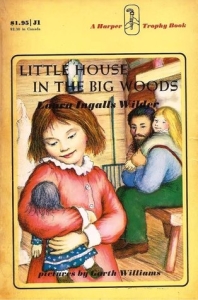 A Deserving Classic
A Deserving Classic
Author: Laura Ingalls Wilder
The Little House books, and the many series and prequels that followed, were a staple of my childhood. Memories almost as old as myself have me tucked in bed, with my mother reading of Laura and Mary’s adventures (and later Rose’s) and cross-country moves had me snuggled in hotel beds taking advantage of that wondrous cable to watch the adaption mini-series. Prowling through Barnes and Noble with the boyfriend, swearing I would buy nothing, I ran into a lovely leather bound edition including the first give novels in the series along with original artwork by Garth Williams. I, of course, caved to nostalgia and bought it.
As pretty much everyone knows, the Little House series begins in 1871 and contains the sometimes desperate, often cozy, stories of a pioneer family as they live off the land and move westward with the rush. The story is told from the prospective of Laura, the middle daughter, who loves playing with her corncob doll, thrills to her Pa’s stories of the wild woods, and is quite a bit jealous of her older sister with the golden curls. Little House in the Big Woods is the first novel in the series (which is actually quite autobiographical – but let’s not nitpick over genre just yet). The story starts with a very young Laura who lives in a cabin in the Big Woods near Lake Pepin, Wisconsin. This is before the family begins to move farther west, and depicts the harsh winters with their beautiful yet perilous snow falls; the trials of gathering food and hunting; the joys of visiting relatives; the treasure of Pa’s fiddle and singing by the fire; and above all the wonder at life as seen through a child’s eyes.
Other books in the series approach more difficult themes: danger on the Prairie, death, hardship, poverty, etc. Little House in the Big Woods is more concentrated on the cozy aspect of a hard working life and oscillates between describing the hard manual labor of Laura’s and her family’s life and the rewards of family time, the festivities of Maple gathering, and the joys of handmade Christmas presents. There are many sequences concentrated on Pa’s hunting adventures and the butchering of animals in preparation for the long winter. The story, at this juncture, is more about atmosphere and establishing character. As the girls grow older, subsequent books reveal more danger while still keeping the theme established here and the homey quality of the narrative.
Back when I was a child and first discovering reading, the main point of any book was the pictures, and I lamented over those “boring adult books” with only words. I would spend hours pouring over the Little House illustrations in my mother’s vintage 1970s set of books with the original pictures included. Done in a charcoal like etching (although I believe colorized versions are available as well) the illustrations capture the mood of the novel and make readers feel in the action and attached to this family who, over time, feels like an extension of our family. I highly recommend (ok, no, insist) that readers find editions with illustrations since these are one of the most enjoyable and unique elements of the series, always sure to entertain children and adults alike.
The writing, while simple enough for the understanding of a child (if not their limited reading skills) is lush and descriptive yet homey, conversational, and very much an echo of a child’s mind. Descriptions of snows, dances, and the woods blooming into spring captivate as though we are seeing them all for the first time, and the freshness of the narrative inspires a matching wonder of the world in the reader.
As a child I adored this series; as an adult it still doesn’t disappoint and I fell back into the cozy aura of the Ingalls family. Highly recommended!
- Frances Carden
- Book Vs Movie: The Shining - April 6, 2020
- Thankful For Great Cozy Mysteries - December 13, 2019
- Cozy Mysteries for a Perfect Fall - October 20, 2019

Leave A Comment